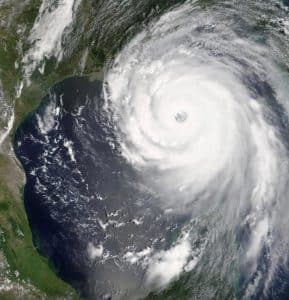Katrina, Twenty Years Later
Recollections of a Windblown Executive Director
by Susan G. D’Antoni, FAAMSE
CEO, MCMS
In some respects, it feels like only yesterday when a Category 4 hurricane, named Katrina, hit Louisiana and Mississippi and changed my life in an instant. In other ways because much time has passed and much life has been lived, it feels like a lifetime ago.
As you may recall, I was the Executive Director of Orleans Parish Medical Society (OPMS) aka Ground Zero, when Katrina occurred. I had been in that role since 1996. On Friday, August 26, 2005, I told our OPMS staff that the approaching hurricane felt different to me – that I feared we would not return to work on Monday as usual. They shrugged their shoulders indicating that it felt like hurricane warnings of the past which were predicted to come our way but then veered east or west.
Later that same afternoon, I received an email notice from the building management suggesting that we should raise our office blinds completely and remove everything off the tops of our desks in preparation for the hurricane to protect our own computers and papers in the event windows were blown out from the impact of the hurricane’s strong winds.
I left the office that day knowing there was still time to return to comply with the building management’s requests in the event the hurricane continued on the predicted path.

People fleeing New Orleans waited outside their cars for traffic to pick up. The city was under an evacuation order as Hurricane Katrina approached. (Rick Wilking/Reuters)
On Saturday morning we awoke to increasing concern that Hurricane Katrina was indeed headed straight for New Orleans. My son, Evan, accompanied me downtown to the medical society’s offices to unplug all the computers and to relocate them under desks and to put away all papers and files in secure locations, and we raised the window blinds as instructed.
At the same time as many were taking their own personal precautions and determining evacuation plans, our Medical Society was at the center of the city’s disaster planning which was in high gear.
OPMS had a very active EMS Committee which provided integral expertise to the City’s Administration on appropriate actions to take related to medical care. Dr. Jim Aiken, an EMS Physician, was OPMS’ representative. He had hunkered down with city leadership as Katrina approached.
As the Society’s Executive Director, I asked him if I should stay in the city to be of help. He advised me to evacuate with my family. Since I was not a clinician, he thought I would be of more help in the aftermath. On Sunday morning, leaving our cat alone in our house, we evacuated with our two children, my husband’s parents, and two days’ worth of clothing.
On Monday, we did not return to the medical society’s offices on the 13th floor of the Texaco Building as Katrina was making landfall near New Orleans as predicted as a Category 4 hurricane.
Interestingly, sometime before Katrina, I had met with a state health officer about scenario planning if a major storm were to hit the mouth of Lake Pontchartrain. Everyone’s worst fears were coming true.
With my family safely ensconced in a Tuscaloosa, Alabama hotel, we lost power and found ourselves watching one battery-operated television in the lobby. The reality set in. The levees were breaking, and the city was flooding.
Cell phones didn’t work due to towers being down; however, texting did work. I received my first-ever text from Dr. Aiken asking me how we were and giving me an update on the city. Soon, thanks to the connections of a New Orleans surgeon and future president of the American Medical Association, Dr. Donald Palmisano, twenty-five health care leaders, including myself, received BlackBerry devices with a year’s worth of service. These devices became a lifeline to learn what was happening on the ground and to be able to communicate with each other.
For years, I received phone calls from patients who were displaced to faraway places attempting to find their physicians or their medical records or both. My 707 phone number was on the Internet and shared liberally with evacuees. I still have that 707 phone number. It’s a small reminder of what we all experienced.
I bought a laptop without Finance Committee approval recognizing that I needed to use every possible way to connect with our employees and elected physician leadership. We used a dial-up Internet connection at my mother’s home which was now my remote office to connect to the outside world.
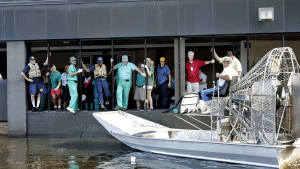
An airboat pulls up to Memorial Medical Center in New Orleans on Aug. 31, 2005. (Bill Haber/AP Photo)
In those early days, the conditions under which heroic efforts of physicians and other clinicians to evacuate patients from acute care hospitals and nursing homes were unimaginable. No electricity. No running water. No elevator service. Evacuations by airlift off the top floors of hospital parking decks became the surreal norm. This played out on television channels across the country. The death toll increased with each passing day as flood waters dissipated. Uncertainty and desperation were common.
Daily scheduled calls ensued to inform key health care leaders to know the latest – number of open beds, mortality statistics, updates on the federal response etc. Physicians were attempting to return to New Orleans only to find their homes or practices or both flooded or their patients scattered throughout the U.S. It seemed impossible to quickly re-establish their medical practices. Some stayed and others relocated recognizing that they needed to find opportunities to practice medicine which were more financially secure and which offered a quality of life not available in New Orleans at present.
For the next almost three months, we lived with my mother in Decatur, Alabama where we enrolled our children in schools and attempted to regain “normalcy” – whatever that was. On Day 19, my husband and I ventured back to New Orleans for the first time. It was the first day the Lake Pontchartrain Causeway opened to allow residents to enter. We were issued Patriots Passes and were instructed to go to the University of New Orleans along a makeshift road along the Lake which was manned by the National Guard who checked our residency status. The “bowl” was still flooded closing access to normal thoroughfares.
We went to the University of New Orleans and received MRE’s (Meals Ready to Eat) and signed waivers allowing us to access our Lake Terrace home which we knew had been flooded based on the satellite images which were widely circulated.
We were allowed back in the parish to save our cat, Coco. We prayed the water level and temperature in our home had not caused her to perish.
What we found when we arrived at our house was not unlike many returning residents’ experience – but we were more fortunate than most. Our home was not a total loss. We started recovery and mold remediation efforts immediately. And, we found a very hungry, angry cat who was upset with us for not taking her when we evacuated.
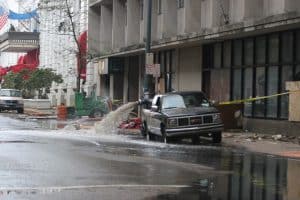
Driving through New Orleans after Hurricane Katrina -University Place by the Roosevelt (Wikimedia)
My next priority was getting to medical society’s offices. I had learned that the Texaco building had sustained damage including some loss of windows but not in our suite on the 13th floor. Thirteen was not an unlucky number after all.
My husband and I took a red wagon to help us remove computers, checkbooks and letterhead. We were rerouted several times because water was still standing in various areas of the city. When we finally arrived to the Central Business District, like most areas of the city, it was a ghost town except for military vehicles and a few other people who occupied suites in the building. There was only one working elevator and no electricity in any of the offices. The windows provided the only light that we had to quickly remove technology and office supplies for our makeshift evacuation offices. We moved swiftly as the temperatures in the building were unbearable.
My husband began showing signs of early heatstroke. To cool him down, I went to the women’s restroom in the dark corridors by feeling my way down hallways I had frequently walked. Once there, I wet paper towels with water from the toilets since the building had no running water. Applying these cool, wet paper towels to his face and neck gave him enough relief to be able to get on his feet to exit the office and make way to the only working elevator. We pushed our way on despite objections by enraged occupants who protested that the elevator was too full. We were all in the same traumatized state, grabbing whatever we could in the allowed thirty minutes to operate our businesses in our remote locations.
I located the whereabouts of some of the OPMS physician leadership and all of staff. We worked remotely before that was a “thing.” We worked with the Louisiana State Medical Society to locate physicians who had been displaced.
Since we had recently formed the Greater New Orleans Medical Foundation, a 501c3 public charity, I spent many, many hours into the middle of the night reaching out to medical societies across the country asking for tax deductible donations to help physicians’ recovery. This tear-filled effort to ask for help in our time of need was not successful as we were competing for donations with many other organizations given the widespread devastation.
The American Medical Association donated $25,000 to our medical society to help with our operations. They provided similar grants to neighboring parish medical societies as well. As a membership organization reliant on dues, our revenue took a direct hit because physicians had relocated permanently or could not receive a paper dues notice as mail wasn’t delivered to New Orleans residents fully until April 2006.
We went from an organization of 1,200 dues paying members to 300 seemingly overnight. Our medical society and the for-profit subsidiary went from a staff of seven to one and a half FTEs. As soon as was feasible, we relocated our offices to a nearby hospital property where rent was free to conserve Society resources while maintaining a level of operations to help physicians in any way possible as they returned to a level of practice.
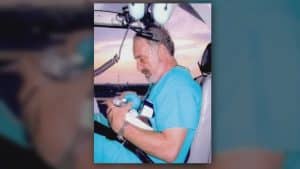
Dr. Juan Gershanik evacuated high-risk infants from a hospital during the storm: he had a recent reunion with the baby he saved, who’s now a 20-year-old man. (9news.com)
I coordinated a visit by Edward Hill, MD, then President of the AMA, to witness the devastation and miraculous recovery which was already taking place. To demonstrate the impact of Katrina on physicians’ lives and practices, we went to the gutted home of a physician, the flooded office of a pediatrician where the entire office including patient records had been destroyed by the force of the flood waters, and to Chalmette (close to the infamous 9th Ward) where an internist was already seeing patients in a makeshift practice with the financial help of the Sisters of Charity. My goal was to demonstrate the resilience and innovation of our medical community. John Pope, an award-winning healthcare journalist with the Times Picayune, rode with us on that bus to capture the impressions of the AMA President whose own home state of Mississippi was impacted as well. I had truly hoped that I could encourage the AMA to bring more organized medicine leaders to New Orleans, just as we had encouraged more Congressional leaders to personally witness the disaster’s impact.
Over the course of several months, I met with national media, researchers, and policymakers to share New Orleans medical community’s story with the goal of improving disaster preparedness efforts for the future and most importantly personalizing the impact of Katrina on physicians and the patients they cared for. I served on several committees of the Bring New Orleans Back Commission as did medical society physician leaders.
Recognizing our Society’s financial reserves were limited, I was faced with one of the toughest personal decisions of my life. Remaining with OPMS meant draining the Society’s reserves with each payroll and limiting its ability to survive. Leaving the medical society meant a more financially secure future for my family but leaving behind the passionate mission-driven work I had been called to do. Physicians in New Orleans were my family too.
Six months after Hurricane Katrina, I applied on the last day of March 2006, which was the deadline for applications to become the next Executive Director of Montgomery County Medical Society. Soon, I was interviewing with the search committee, chaired by Dr. Bruce Smoller. In early May, I was offered the challenging position by Dr. Stephen Rockower, MCMS’ President. What did this mean? Were we really leaving New Orleans?
So many families had already made this very tough decision to relocate to find financial security which the post-Katrina New Orleans economy could not offer. Their stories filled the pages of the Times-Picayune. One Saturday night in early June, I prayed that God would send us a sign that this was His will. By Sunday at noon, we received five signs that moving to Montgomery County was indeed the direction we should take. It was hard to argue with five signs from above.
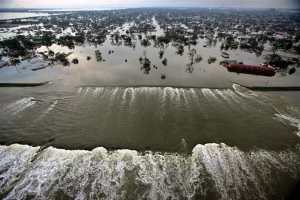
Aerial photograph of the devastation caused by the high winds and heavy flooding in the greater New Orleans area following Hurricane Katrina, August 30, 2005. Reuters/Vincent Laforet/Pool
Leaving New Orleans in August of 2006 was extremely hard for me and my husband, a fifth generation New Orleanian, and my children, Evan and Christina, who were at the tender ages of 16 and 12 respectively.
Before we relocated, I was awarded Honorary Membership in OPMS – one of the greatest honors of my career. (In 2021, I was awarded the Medical Executive Award by the AMA due in part to my efforts related to Katrina recovery.)
The ripple effect of Katrina and relocation continued to be felt by our family for years as it did for so many families who faced the same dilemma, and for families who chose to stay. We struggled for quite some time with PTSD and to make Maryland feel like “home.”
Over the years, I remained in touch with New Orleans physicians as many are still friends. I was elated when I received an email in 2016 from the president of the medical society in New Orleans, to help OPMS do a strategic plan. He and others knew physicians needed a voice.
I shared this request with Montgomery County Medical Society’s leadership, and they wholeheartedly approved my working with the physicians in New Orleans to find that voice again. They knew my heart still ached for the physicians of New Orleans.
I worked with the leadership of the two parish medical societies to evaluate the changing needs of the medical community. Katrina pushed most physicians who were significantly affected by the storm into employment – now a trend seen throughout the United States. Physicians were now W-2 employees of Ochsner, LCMC, Touro Infirmary and University Medical Center.
The impact of Katrina had clearly not stopped at the 17th Street Canal which separated Orleans and Jefferson Parishes, and the challenges of the medical community were more regional in 2016 than they had been before. It was apparent that a regional medical society would better serve the physicians and people of the Greater New Orleans area.
Over the course of the next several years and many iterations of bylaws to make sure a new umbrella organization would effectively represent all physician’s interests, the Medical Association of Southeast Louisiana was born under the visionary leadership of several key physicians.
It’s been my privilege to work with dedicated physician leaders throughout New Orleans to bring value to the medical community and their patients. I am proud to have played a role in OPMS’ history and MASELA’s founding. I’m excited for the future of MASELA, and OPMS and JPMS.
Likewise, I am excited by the opportunities which Montgomery County Medical Society has before us. It’s been nineteen years since I became the Executive Director of Montgomery County Medical Society. The Executive Board saw my potential to lead despite being windblown and arriving with a lot of psychological baggage.
MCMS leaders who are now friends provided a soft landing. They welcomed me and my family. They provided medical care, support and a listening ear when needed by any of us.
Since that time, together with the leaders and members of MCMS, we have made incredible progress and supported physicians and patients needs through another disaster – COVID; yet, there is so much more to be done. As Bob Dylan said, “These times they are a-changin”……again. The change this time has come not from a natural disaster but from political forces which have disrupted the very foundation of public health, science and our health care system. This crisis is indeed another opportunity for organized medicine to come forward.
On a personal note, my hurricane surviving cat, Coco, lived to be 21 years old and died on her favorite pillow in our home. Christina, now 32, is a professor at American University in Creative Writing where she teaches college students how to express themselves – a talent she used to get through those early post-Katrina years. Her thesis was entitled, “Water Damage.” Evan, 36, is a Physician Assistant in New Orleans. He returned “home” to care for others to show the compassion to his patients that was shown to us.
Edward and I are blessed to live in Maryland where we’ve made a home and life-long friends. We found a place where we could start healing as a family, and where I could once again find mission-driven work with physicians. I enjoy being your cheerleader and your advocate – just as I did for the physicians of windblown, flooded New Orleans in the aftermath of one of the greatest natural disasters to hit the United States.

